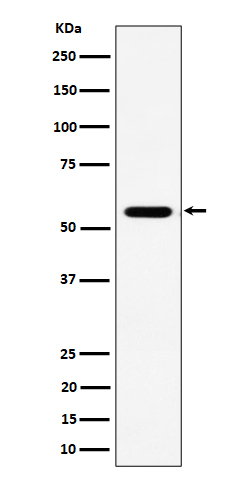RNF14 Antibody
Rabbit mAb
- 产品详情
- 实验流程
Application
| WB |
|---|---|
| Primary Accession | Q9UBS8 |
| Reactivity | Rat, Human, Mouse |
| Clonality | Monoclonal |
| Other Names | ARA54; HFB30; Rnf14; TRIAD2; |
| Isotype | Rabbit IgG |
| Host | Rabbit |
| Calculated MW | 53837 Da |
| Dilution | WB 1:500~1:2000 |
|---|---|
| Purification | Affinity-chromatography |
| Immunogen | A synthesized peptide derived from human RNF14 |
| Description | Might act as an E3 ubiquitin-protein ligase which accepts ubiquitin from specific E2 ubiquitin-conjugating enzymes and then transfers it to substrates, which could be nuclear proteins. Could play a role as a coactivator for androgen- and, to a lesser extent, progesterone-dependent transcription. |
| Storage Condition and Buffer | Rabbit IgG in phosphate buffered saline , pH 7.4, 150mM NaCl, 0.02% sodium azide and 50% glycerol. Store at +4°C short term. Store at -20°C long term. Avoid freeze / thaw cycle. |
| Name | RNF14 {ECO:0000303|PubMed:36638793, ECO:0000312|HGNC:HGNC:10058} |
|---|---|
| Function | E3 ubiquitin-protein ligase that plays a key role in the RNF14-RNF25 translation quality control pathway, a pathway that takes place when a ribosome has stalled during translation, and which promotes ubiquitination and degradation of translation factors on stalled ribosomes (PubMed:36638793, PubMed:37651229, PubMed:37951215, PubMed:37951216). Recruited to stalled ribosomes by the ribosome collision sensor GCN1 and mediates 'Lys-6'-linked ubiquitination of target proteins, leading to their degradation (PubMed:36638793, PubMed:37651229, PubMed:37951215, PubMed:37951216). Mediates ubiquitination of EEF1A1/eEF1A and ETF1/eRF1 translation factors on stalled ribosomes, leading to their degradation (PubMed:36638793, PubMed:37651229). Also catalyzes ubiquitination of ribosomal proteins RPL0, RPL1, RPL12, RPS13 and RPS17 (PubMed:36638793). Specifically required to resolve RNA-protein cross-links caused by reactive aldehydes, which trigger translation stress by stalling ribosomes: acts by catalying 'Lys-6'-linked ubiquitination of RNA-protein cross-links, leading to their removal by the ATP-dependent unfoldase VCP and subsequent degradation by the proteasome (PubMed:37951215, PubMed:37951216). Independently of its function in the response to stalled ribosomes, acts as a regulator of transcription in Wnt signaling via its interaction with TCF transcription factors (TCF7/TCF1, TCF7L1/TCF3 and TCF7L2/TCF4) (PubMed:23449499). May also play a role as a coactivator for androgen- and, to a lesser extent, progesterone-dependent transcription (PubMed:19345326). |
| Cellular Location | Cytoplasm. Nucleus |
| Tissue Location | Widely expressed.. |
Research Areas
For Research Use Only. Not For Use In Diagnostic Procedures.
Application Protocols
Provided below are standard protocols that you may find useful for product applications.
终于等到您。ABCEPTA(百远生物)抗体产品。
点击下方“我要评价 ”按钮提交您的反馈信息,您的反馈和评价是我们最宝贵的财富之一,
我们将在1-3个工作日内处理您的反馈信息。
如有疑问,联系:0512-88856768 tech-china@abcepta.com.
¥ 1,500.00
Cat# AP92914























 癌症的基本特征包括细胞增殖、血管生成、迁移、凋亡逃避机制和细胞永生等。找到癌症发生过程中这些通路的关键标记物和对应的抗体用于检测至关重要。
癌症的基本特征包括细胞增殖、血管生成、迁移、凋亡逃避机制和细胞永生等。找到癌症发生过程中这些通路的关键标记物和对应的抗体用于检测至关重要。 为您推荐一个泛素化位点预测神器——泛素化分析工具,可以为您的蛋白的泛素化位点作出预测和评分。
为您推荐一个泛素化位点预测神器——泛素化分析工具,可以为您的蛋白的泛素化位点作出预测和评分。 细胞自噬受体图形绘图工具为你的蛋白的细胞受体结合位点作出预测和评分,识别结合到自噬通路中的蛋白是非常重要的,便于让我们理解自噬在正常生理、病理过程中的作用,如发育、细胞分化、神经退化性疾病、压力条件下、感染和癌症。
细胞自噬受体图形绘图工具为你的蛋白的细胞受体结合位点作出预测和评分,识别结合到自噬通路中的蛋白是非常重要的,便于让我们理解自噬在正常生理、病理过程中的作用,如发育、细胞分化、神经退化性疾病、压力条件下、感染和癌症。






